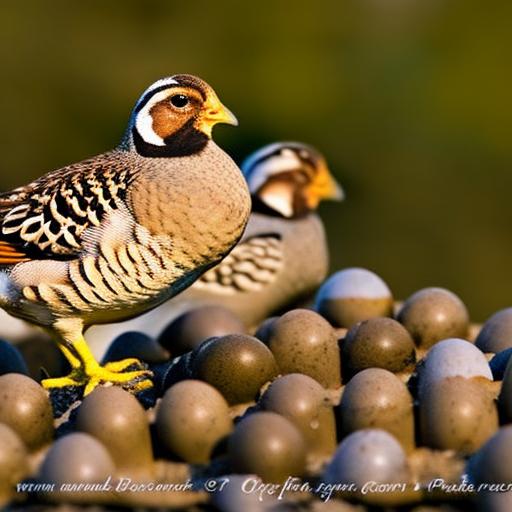Coturnix quail, also known as Japanese quail, are popular among poultry enthusiasts for their small size, fast growth, and high egg production. There are several different breeds of Coturnix quail, each with its own unique characteristics and traits. These breeds come in a variety of colors and patterns, making them not only productive but also aesthetically pleasing. Whether you are interested in raising quail for meat, eggs, or as pets, there is a Coturnix quail breed that will suit your needs. In this article, we will explore the common and rare breeds of Coturnix quail, their characteristics, and how to select the right breed for your specific goals. We will also discuss breeding and raising techniques for different quail breeds, providing a comprehensive guide for both novice and experienced quail breeders.
Key Takeaways
- Coturnix quail breeds are popular for their small size, fast growth, and high egg production.
- Common coturnix quail breeds include the Pharaoh, Italian, and Tuxedo varieties.
- Rare and exotic coturnix quail breeds such as the Tibetan and Golden Manchurian are sought after by breeders for their unique colors and patterns.
- Different coturnix quail breeds have varying characteristics and traits, including egg color, size, and temperament.
- When selecting a coturnix quail breed, consider factors such as egg production, meat quality, and color preferences.
Common Coturnix Quail Breeds
The most common breed of Coturnix quail is the Pharaoh quail, also known as the wild-type quail. This breed is characterized by its brown and white speckled feathers, making it a popular choice for both meat and egg production. Another common breed is the Tuxedo quail, which has a striking black and white color pattern that sets it apart from other quail breeds. The Texas A&M quail is another popular breed known for its high egg production and fast growth rate. This breed is often favored by commercial quail farmers for its efficiency in egg production. The Italian quail is another common breed that is known for its beautiful plumage and friendly disposition. These common breeds are readily available from hatcheries and are often the first choice for beginners looking to start their quail flock.
Rare and Exotic Coturnix Quail Breeds
In addition to the common breeds, there are also several rare and exotic Coturnix quail breeds that are prized for their unique colors and patterns. The Tibetan quail is a rare breed known for its stunning blue-gray feathers and gentle nature. The Golden Manchurian quail is another rare breed that is highly sought after for its striking golden coloration. The Roux Dilute quail is a rare mutation that results in a dilute coloration, giving the bird a soft, pastel appearance. The Rosetta quail is another exotic breed with a beautiful rosette pattern on its feathers, making it a favorite among collectors and enthusiasts. These rare and exotic breeds are often more difficult to find and may require special care and attention, but they can be a rewarding addition to any quail flock.
Characteristics and Traits of Different Coturnix Quail Breeds
Each Coturnix quail breed has its own unique characteristics and traits that make it suitable for different purposes. The Pharaoh quail, for example, is known for its hardiness and adaptability, making it an excellent choice for beginners or those looking to raise quail for meat production. The Tuxedo quail, on the other hand, is prized for its striking appearance and is often kept as pets or for exhibition purposes. The Texas A&M quail is favored for its high egg production, making it a popular choice for those looking to raise quail primarily for eggs. The Italian quail is known for its friendly disposition, making it a great choice for those looking to keep quail as pets or for educational purposes.
Selecting the Right Coturnix Quail Breed for Your Needs
When selecting a Coturnix quail breed, it’s important to consider your specific goals and needs. If you are primarily interested in meat production, you may want to choose a breed known for its fast growth rate and large size. If you are focused on egg production, you will want to select a breed with a reputation for high egg production. For those interested in keeping quail as pets or for exhibition purposes, appearance and temperament will be important factors to consider. It’s also important to consider the availability of the breed in your area, as well as any special care requirements they may have. By carefully considering your goals and doing research on the different breeds, you can select the right Coturnix quail breed to meet your specific needs.
Breeding and Raising Coturnix Quail of Different Breeds

Breeding and raising Coturnix quail of different breeds requires careful attention to their specific needs and characteristics. When breeding different quail breeds, it’s important to keep track of lineage and genetics to maintain the desired traits and characteristics of each breed. Housing requirements may vary depending on the breed, with some breeds requiring more space or specific environmental conditions. Nutrition also plays a crucial role in raising healthy quail of different breeds, as their dietary needs may vary based on their size, growth rate, and egg production. Additionally, it’s important to consider the temperament of different breeds when raising them together, as some breeds may be more aggressive or territorial than others.
Conclusion and Further Resources for Coturnix Quail Breeders
In conclusion, Coturnix quail come in a variety of breeds, each with its own unique characteristics and traits. Whether you are interested in raising quail for meat, eggs, pets, or exhibition purposes, there is a Coturnix quail breed that will suit your needs. By carefully considering your goals and doing research on the different breeds, you can select the right breed to meet your specific needs. Breeding and raising Coturnix quail of different breeds requires careful attention to their specific needs and characteristics, including housing, nutrition, and temperament considerations. For further resources on Coturnix quail breeding and raising, there are many online forums, books, and local poultry clubs that can provide valuable information and support for both novice and experienced quail breeders. With the right knowledge and resources, you can successfully raise healthy and productive Coturnix quail of different breeds.
If you’re interested in learning more about coturnix quail breeds, you might also want to check out Poultry Wizard’s article on the incubation period for goose eggs. Understanding the incubation process for different poultry can provide valuable insights into the care and breeding of various bird species. For more information on creating a suitable environment for your quails, you can also explore their article on Snaplock chicken coop.
FAQs
What are the different breeds of coturnix quail?
There are several different breeds of coturnix quail, including the Pharaoh, Italian, Tuxedo, Texas A&M, and Jumbo.
What are the characteristics of the Pharaoh coturnix quail breed?
The Pharaoh coturnix quail breed is known for its brown and white speckled feathers and is one of the most common and popular breeds of coturnix quail.
What are the characteristics of the Italian coturnix quail breed?
The Italian coturnix quail breed is known for its unique coloring, with a combination of brown, white, and black feathers.
What are the characteristics of the Tuxedo coturnix quail breed?
The Tuxedo coturnix quail breed is known for its striking black and white coloring, with a distinct tuxedo-like pattern on its feathers.
What are the characteristics of the Texas A&M coturnix quail breed?
The Texas A&M coturnix quail breed is known for its solid white feathers and is often bred for its high egg production.
What are the characteristics of the Jumbo coturnix quail breed?
The Jumbo coturnix quail breed is larger in size compared to other breeds and is often bred for its meat production.
Meet Walter, the feathered-friend fanatic of Florida! Nestled in the sunshine state, Walter struts through life with his feathered companions, clucking his way to happiness. With a coop that’s fancier than a five-star hotel, he’s the Don Juan of the chicken world. When he’s not teaching his hens to do the cha-cha, you’ll find him in a heated debate with his prized rooster, Sir Clucks-a-Lot. Walter’s poultry passion is no yolk; he’s the sunny-side-up guy you never knew you needed in your flock of friends!







